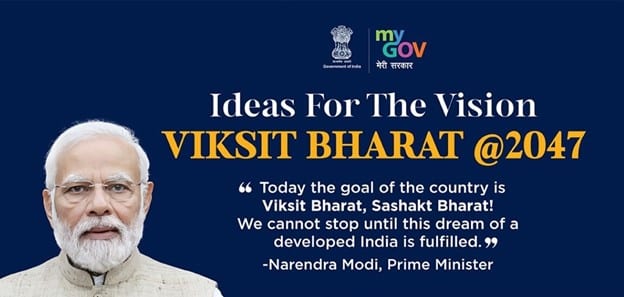Vision for Rural Development: Viksit Bharat 2047

The Indian government has set an ambitious goal for the future: a ‘Viksit Bharat 2047’. This vision aims to create a developed India that embodies the principle of ‘Sabka Saath, Sabka Vikas’, meaning ‘Together with All, Development for All’. The focus is on enhancing the quality of life and ensuring equitable development, particularly in rural areas. The Economic Survey 2024-25, presented in Parliament by Union Minister for Finance and Corporate Affairs, Smt. Nirmala Sitharaman, outlines this comprehensive approach. It emphasizes a ‘Welfare for All’ strategy, achieved through a ‘Whole of Government’ framework.
The government has initiated various measures to improve rural infrastructure, housing, sanitation, and livelihoods. The integration of technology and digitization into rural economies is also a significant focus. This article delves into the key aspects of the government’s rural development agenda, highlighting infrastructure improvements, housing initiatives, and efforts to enhance rural incomes.
Strengthening Rural Infrastructure
Rural infrastructure development is a cornerstone of the government’s strategy. The Economic Survey details the progress made under various initiatives aimed at enhancing rural connectivity and facilities. A notable initiative is the special focus on Particularly Vulnerable Tribal Groups (PVTGs). Under the Pradhan Mantri Gram Sadak Yojana (PMGSY), a separate vertical has been launched to improve road connectivity in PVTG areas. This initiative relaxes population norms to include smaller habitations, targeting the construction of 8,000 kilometers of roads.
Additionally, the government is investing in essential services such as drinking water, health, and sanitation. Improved rural housing is also a priority, with efforts to ensure that every household has access to clean fuel and social protection. The integration of technology into these initiatives is crucial. By digitizing agricultural activities and governance, the government aims to streamline processes and enhance efficiency. This comprehensive approach to rural infrastructure is vital for fostering economic growth and improving the quality of life in rural communities.
Housing Initiatives: A Path to Economic Growth
Housing is a fundamental aspect of rural development. The Economic Survey highlights the importance of providing safe and affordable housing for economically disadvantaged households. The Pradhan Mantri Awaas Yojana-Gramin (PMAY-G) has been instrumental in this regard. Since its inception in 2016, the scheme has successfully constructed 2.69 crore houses. This initiative aligns with Sustainable Development Goal (SDG) 11.1, which emphasizes safe and affordable housing.
The construction of homes under PMAY-G not only provides shelter but also generates significant employment opportunities. Each house built creates approximately 314 person-days of work, including skilled, semi-skilled, and unskilled labor. In the first two years of the scheme alone, it generated 4.82 crore person-days for skilled labor and 7.60 crore person-days for unskilled labor. This employment generation is crucial for boosting local economies and improving living standards in rural areas.
Enhancing Rural Incomes Through Employment Schemes
The government is committed to enhancing rural incomes through various employment schemes. The Mahatma Gandhi National Rural Employment Guarantee Scheme (MGNREGS) plays a pivotal role in this effort. The Economic Survey outlines several reforms aimed at maximizing the scheme’s efficiency. These reforms include geotagging work sites to ensure transparency and accountability. Additionally, 99.98% of payments are processed through the National Electronic Fund Management System, ensuring timely wage transfers.
The Deendayal Antyodaya Yojana – National Rural Livelihood Mission (DAY-NRLM) is another key initiative. This flagship program focuses on poverty alleviation by providing poor households with access to self-employment and skilled wage opportunities. By promoting sustainable and diversified livelihood options, the program aims to uplift the rural population and reduce poverty.
Comprehensive Welfare Measures for Rural Communities
The government’s approach to rural development extends beyond infrastructure and housing. It encompasses health, nutrition, and social inclusion. The DAY-NRLM implements Food, Nutrition, Health, and WASH (FNHW) interventions across thousands of blocks in India. These initiatives address critical issues related to health and sanitation, ensuring that rural communities have access to essential services.
State Rural Livelihood Missions (SRLMs) are also actively working to promote social inclusion and gender equality. Currently, 32 SRLMs are implementing gender-specific interventions to empower women in rural areas. Furthermore, the National Legal Services Authority (NALSA) provides free legal services to disadvantaged groups, ensuring access to justice in remote regions.
Observer Voice is the one stop site for National, International news, Sports, Editor’s Choice, Art/culture contents, Quotes and much more. We also cover historical contents. Historical contents includes World History, Indian History, and what happened today. The website also covers Entertainment across the India and World.

